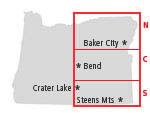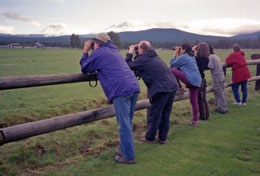Introducing a Ruddy Duck
Malheur National Wildlife Reserve
I am somehow bamboozled into driving an official van for an Audubon
trip to the Malhuer Wildlife Refuge led by expert birder Mike
Houck, AKA an urban naturalist. He has awards upon awards and
has literally put Portland on the map in his efforts to save
urban green spaces. But he was no naturalist hero to me; simply
my old high-school boyfriend. And when he asked me to take the
trip I didn’t hesitate. He and sister Betsy had been conspiring
for years to get me to Malhuer, but living in LA, it wasn't that
convenient. Now, with a move back to Oregon after thirteen years
south, it was.
How Houck ever became a bird watcher extraordinaire, I shall never
know. He was a jock in high school, a state miler. Nary a hint
of interest in the wonders of nature, let alone bird watching,
which somehow seems fantastic. Now this is where my perception
of birders falls apart. When I think of bird watchers, I think
of eccentric, introverted, nerdy types, kinda wimpy if male,
certainly never athletic or good looking. Houck doesn't fit the
description at all (except for eccentric). So why am I so prejudiced?
Perhaps it's because birders always seem to wear such goofy clothes.
I guess we all judge people by clothes or profession and then
are dumbfounded when we actually like someone we could never
in a million years imagine we could align with, understand, admire,
love, even. I, however, have the advantage of knowing Houck for
thirty some years and so accept whatever he chose to be. Even
a birder.
So. Here I was, off to remote southeastern Oregon with a group
of urbane Audubon birders. There were two vans for twelve of
us. Six in each vehicle. I felt incredibly inadequate as a leader
of sorts. I know next to nothing about birds. I figured there
were only a couple of things I could do as I hurtled into this
situation: try real hard to be nice to these strangers and try
my darndest not to back into a ravine.
The first day took us thirteen hours to get to Malhuer as we
had to stop off at various locations along the way to look at
birds. The first stop on the Santiam Pass, as we pile out of
the vans and everyone takes their places in the parking lot with
binoculars trained in the trees and sky, I think, "This
is definitely a mistake. A very big mistake." I feel completely
out of my element and wonder why I put myself in some unusual
situations with abandon and why this is bugging me. The only
thing I come up with is: I am not a group person. I never liked
camp, nor tours and this was starting to feel like both. I force
myself to stop thinking and simply go with the program. "After
all," I coach myself, "You're in the woods, it's a
beautiful day, so what's wrong with you?" Then, we walk
over to this cliff and descend a stairway to the river below.
It's stunning. The North Santiam River cascades around a natural
out-cropping of rock and we see a pair of Harlequin ducks, a
bevy of violet green swallows and American dippers dabbling.
Suddenly everything feels better.
As we drive on that east of the mountains
in the higher altitudes, the wildflowers are still in bloom.
Now, there’s something I'm at home with. Houck is also a
botanist and so identifies all the wildflowers. Besides pulling
over for birds, we pull over for flowers. It has now become
a Wildflower and Bird Expedition. Houck frequently makes
stops in the van ahead and shouts back at my van, "Cody, Oenothera tanacetifolia!" Or
some such. This is a gift I appreciate fully.
Sometimes we stop at places you would swear are devoid of birds,
but Houck, who predicts what we will see in each location, calls
them in. Most of the birds appear so suddenly that we accuse
him of paying small children to hide in the woods securing birds
and releasing them when he calls.
At Malhuer, we stay at the field station in run-down dorms, a
former job corps site painted in leftover (but from where?) government
colors, jarring the desert. I especially like the mint green
building although the pukey orange is a close runner-up. Meals
are provided in a common mess hall, which we share with other
bird groups — an Elderhostel group of thirty-three and a small
gathering of the Nature Conservancy.
Men and women are separated in the dorms and I am thankful there
are only six of us women in a dorm meant for twenty-four so we
can spread out and each have our own windows onto the high desert
landscape.
The next morning, I find myself utilizing a skill of my father's
that used to scare us kids to death – the ability to spot a mallard
or a deer a hundred miles away while driving. The thing I don't
inherit from him, happily, is the swerving of the vehicle that
generally went along with the spotting. Oh, I could spot them
all right. I just couldn't identify them.
"Over there on that willow, second branch from the top, a
beautiful little yellow something singing..." Houck tells
me I am doing good, as the hardest part for beginners was learning
to see. I think he was being kind.
I don't know when the true transformation hits me. Maybe it was
the second day, cruising around the meadowlands and waterways
of the wonderful Malhuer reserve, with the profusion of shore
birds — the stilts with their red, red legs, or the avocets,
the cinnamon teals, or the lesser scaup. I think it may have
been the ruddy ducks and their cinnamon heads and periwinkle
blue bills. How could I resist anything so incongruous? Or perhaps
it was the fabulous breakfast, family style, at the French Glen
Hotel. Or perhaps simply enjoying the diverse and, yes, eccentric,
group.
The desert is an incredible place anyway, but green and in bloom
and having all these species to behold too, was exhilarating.
We identified, rather, they identified 131 species. Adding to
this splendid empty landscape were the afternoon thunderstorms
flying across the desert — huge black roiling clouds shot through
with spectacular lightning laid against fields of green illuminated
in sunlight.
I was so relaxed and happy by the third day that I don't know
when I realized this birding business was actually fun. OK, so
I may be hooked, but I refuse to wear those goofy clothes.
The Audubon Society of Portland is dedicated to understanding,
protecting and preserving wildlife with outings in botany, geology,
natural history as well as birding. www.audubonportland.org.
back to top
back
to Southeastern Oregon overview

















